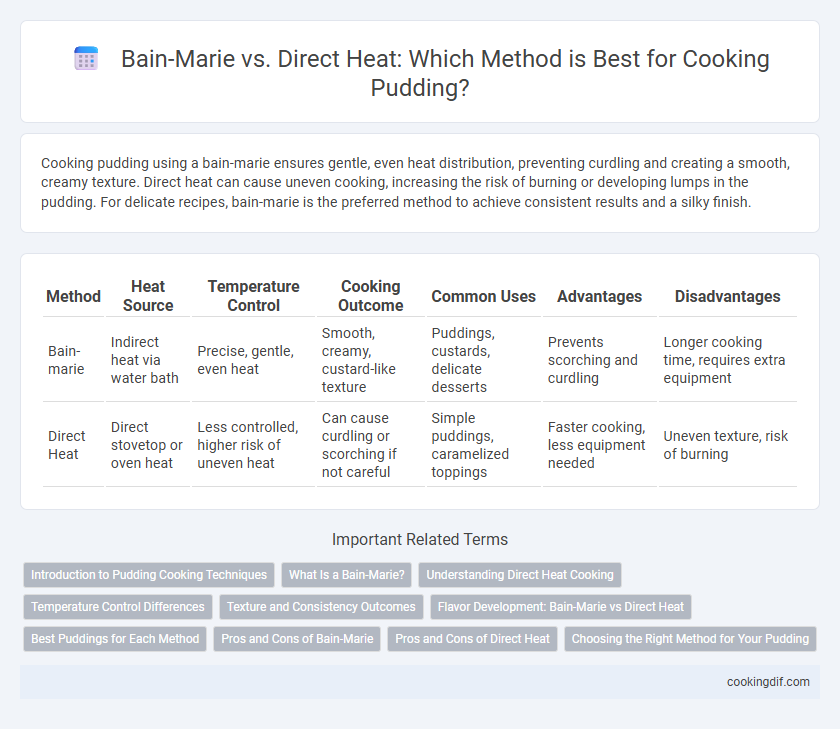Cooking pudding using a bain-marie ensures gentle, even heat distribution, preventing curdling and creating a smooth, creamy texture. Direct heat can cause uneven cooking, increasing the risk of burning or developing lumps in the pudding. For delicate recipes, bain-marie is the preferred method to achieve consistent results and a silky finish.
Table of Comparison
| Method | Heat Source | Temperature Control | Cooking Outcome | Common Uses | Advantages | Disadvantages |
|---|---|---|---|---|---|---|
| Bain-marie | Indirect heat via water bath | Precise, gentle, even heat | Smooth, creamy, custard-like texture | Puddings, custards, delicate desserts | Prevents scorching and curdling | Longer cooking time, requires extra equipment |
| Direct Heat | Direct stovetop or oven heat | Less controlled, higher risk of uneven heat | Can cause curdling or scorching if not careful | Simple puddings, caramelized toppings | Faster cooking, less equipment needed | Uneven texture, risk of burning |
Introduction to Pudding Cooking Techniques
Pudding cooking techniques vary significantly between bain-marie and direct heat methods, each affecting texture and consistency. Bain-marie, or water bath, ensures gentle, even heat distribution, preventing curdling and fostering a smooth, creamy pudding ideal for custards and cheesecakes. Direct heat applies higher, concentrated heat rapidly, which can lead to uneven cooking and risk of burning but is suitable for thick, dense puddings like rice or bread pudding.
What Is a Bain-Marie?
A bain-marie, also known as a water bath, is a cooking technique that uses indirect heat by placing the pudding dish in a container of hot water to ensure even and gentle cooking. This method prevents curdling and overheating, which are common risks with direct heat that can cause the pudding to become grainy or burn. Professional chefs favor bain-marie for delicate custards and puddings to achieve smooth, creamy textures.
Understanding Direct Heat Cooking
Direct heat cooking for pudding involves placing the mixture directly over a heat source, which can cause uneven cooking and risk of scorching, especially for delicate custard-based puddings. This method requires constant stirring and close temperature control to prevent curdling and achieve a smooth texture. Understanding the precise heat levels and timing is crucial for successful direct heat pudding preparation compared to the gentler, more forgiving bain-marie technique.
Temperature Control Differences
Using a bain-marie for pudding cooking offers precise temperature control by surrounding the custard with gently heated water, maintaining an even, consistent heat below boiling point and preventing curdling. In contrast, direct heat exposes pudding to higher, uneven temperatures, increasing the risk of scorching or overcooking due to fluctuating heat levels. Temperature stability in bain-marie cooking ensures a smoother texture and creamier consistency, crucial for delicate puddings like creme caramel or custard-based desserts.
Texture and Consistency Outcomes
Cooking pudding using a bain-marie ensures gentle, even heat distribution, resulting in a smooth, creamy texture with consistent firmness. Direct heat often causes rapid cooking that may lead to curdling or uneven texture, producing a grainier or rubbery consistency. Maintaining low and controlled temperatures with a bain-marie helps achieve the ideal pudding consistency by preventing overheating and preserving delicate ingredients.
Flavor Development: Bain-Marie vs Direct Heat
Using a bain-marie for pudding cooking ensures gentle, even heat distribution, preventing scorching and promoting smooth, creamy texture with delicate flavor development. Direct heat can cause uneven cooking and caramelization, potentially intensifying flavors but risking burnt spots and grainy texture. Bain-marie preserves the subtle sweetness and richness, while direct heat may produce stronger, toasted notes but less controlled flavor balance.
Best Puddings for Each Method
Puddings with delicate textures like custards and creme brulee benefit from Bain-marie cooking, ensuring gentle heat distribution that prevents curdling and promotes smooth consistency. Dense and robust puddings such as bread pudding or sticky toffee pudding perform well over direct heat, where higher temperatures facilitate caramelization and thicker textures. Selecting the right cooking method enhances the pudding's flavor profile and texture, aligning with each recipe's specific requirements for optimal results.
Pros and Cons of Bain-Marie
Bain-marie cooking offers even heat distribution that prevents pudding from curdling or burning, ensuring a smooth texture. The gentle water bath maintains consistent temperature control, which is crucial for delicate custard-based puddings. However, bain-marie methods are slower and require more careful setup compared to direct heat, which can save time but risks uneven cooking and texture issues.
Pros and Cons of Direct Heat
Direct heat cooking of pudding offers faster preparation and straightforward equipment use, making it ideal for quick recipes. However, it poses a higher risk of uneven cooking and burning due to constant high temperatures, potentially resulting in a grainy texture. Careful temperature control and frequent stirring are essential to prevent scorching and achieve a smooth pudding consistency.
Choosing the Right Method for Your Pudding
Choosing the right cooking method for pudding depends on texture and consistency preferences; Bain-marie offers gentle, even heat ideal for silky, smooth results without curdling. Direct heat provides faster cooking but risks uneven temperature and potential burning, affecting delicate custards or creamy puddings. For precise temperature control and superior texture, Bain-marie remains the preferred choice among professional chefs and home cooks.
Bain-marie vs Direct heat for pudding cooking Infographic

 cookingdif.com
cookingdif.com